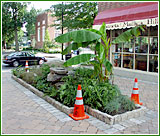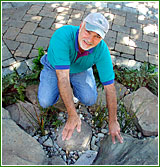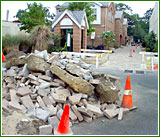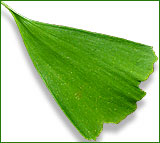HADDONFIELD DINOSAUR CONSTRUCTION SITE NEARS COMPLETION
Sculpture Park in Lantern Lane on Schedule for Hadrosaurus Dedication Oct. 18

By Hoag Levins ...| ...Sept. 8, 2003

Also See:
> THE MAKING OF HADDONFIELD'S DINOSAUR GARDEN
An Illustrated Lantern Lane Construction Chronology
HADDONFIELD, N.J. -- Five weeks after it began in a cloud of bulldozer dust, the construction to prepare Lantern Lane as the new site for a massive dinosaur statue is nearly complete,

|
| Photo: Hoag Levins |
At the Kings Highway end of the 209-foot-long Lantern Lane, a two-foot-high pedestal of pavers, boulders and plants nears completion as the platform from which the one-ton Hadrosaurus foulkii sculpture will rise. The head of the bronze dinosaur will peer down from a height of 10 feet. Also see larger photo.
| according to HATCH, the committee overseeing the project.
The Lane, a broad pedestrian walkway in the center of the town's business district, is being turned into a sculpture garden commemorating Hadrosaurus foulkii, the historic fossil excavated from a local marl pit in 1858.
Oct. 18 dedication
The 8-foot-high, 14-foot-long figure of the Cretaceous-era dinosaur was created by sculpture John Giannotti. Currently being cast in bronze at the Stewart Sculpture foundry in Lambertville, N.J., it is scheduled to be installed and dedicated at the Lantern Lane site on Oct. 18.
"The process took a little longer than planned," said Beverly Aldeghi, co-chair of the HATCH dinosaur sculpture committee and president of the Haddonfield Garden Club. "The crews encountered a lot of concrete they didn't expect under the first layer of old bricks. In some places it was four feet thick and had to be jackhammered out."
The drive to make a dinosaur sculpture the central icon of the village-like community was started by the Haddonfield Garden Club in 2000. The Club, which has long tended the lush gardens in Lantern Lane, organized HATCH (Haddonfield Acts to Create Hadrosaurus) to manage the dinosaur project and its related fund-raising efforts. The HATCH Web site

|
| Photo: Hoag Levins |
Artist John Giannotti points out where the water feature will cascade down the base of the dinosaur sculpture pedestal. Also see larger photo.
| at Hadrosaurus.com includes a complete history of the undertaking.
Extensive construction
This summer's project to reconfigure the Lane involved digging up its entire 209-foot length. New plumbing, electrical service, garden areas, irrigation systems, and park-like bench areas were installed or created. The overall design and construction was overseen by landscape architect Al Masullo of Knolltop Nursery in Haddonfield. The paver work was done by by McCrindle Paver Systems of Collingswood with materials donated by the EP Henry Corporation of Woodbury.
The lane was resurfaced with more than 4,000 8-inch by 12-inch pavers. Sections of the pavers will ultimately include hundreds of blocks custom engraved with names and messages of donors who sponsored a paver to support the project. According to Aldeghi, the last round of paver engraving orders has not yet gone in; orders may still be placed with an order form found on Hadrosaurus.com.
The largest obvious change in Lantern Lane is the addition of an island-like pedestal of natural rocks to which the massive dinosaur sculpture will be permanently attached. The pedestal, like the sculpture it will soon support, looks out on the sidewalk of Kings Highway.

|
| Photo: Hoag Levins |
Lantern Lane's heavy construction was completed during the first week of Sept. Remaining work is now focused on the finishing touches. Also see larger photo.
|
Highly memorable landmark
Perched atop the rocky base, the head of Hadrosaurus foulkii will hover nearly ten feet above pedestrians and serve as a highly memorable landmark visible to every car passing along the heavily-trafficked Kings Highway, the town's main street.
The one-ton sculpture is being completely assembled at the foundry and will be trucked to Lantern Lane and lifted into place by a large crane. That fact made the final tweaking of the Lane's pedestal area a precision task, according to sculptor Giannotti. The uneven lower surfaces of the massive sculpture must meet the rough stone mound at four spots on different levels with different angles.
"Al Masullo is a poet with stone, and his crews know they are working on something special," said Giannotti. "You can see it in their faces and, more importantly, in their attitude. The other day, for example, I showed up with a three-dimensional wooden Rube Goldberg contraption that included the footprints and paw placement of the dinosaur so we could exactly fit it onto the rocks. Many construction workers would have laughed me off the site after seeing such a goofy, thing but these guys took it all in stride and went about shifting huge boulders ever so slightly for the final fit.

|
| Photo: Hoag Levins |
The ginkgo is called a 'living fossil' because it is one of the few plants that hasn't changed since the Cretaceous days of the dinosaur. Here, its distinctive leaf.
|
'Communal gothic cathedral'
"It's typical of the wonderful cooperation and sheer joy I have sensed from everybody involved in this thing from the very beginning," said Giannotti. "It's almost as though we're building some kind of communal gothic cathedral."
At the opposite, parking-lot end of the Lane, two large ginkgo trees have just been installed. This "Gate of Ginkgo" is particularly appropriate because ginkgo, often known as a "living fossil" is one of the few plants that still survives today from the Cretaceous era when Hadrosaurs roamed the earth. Ginkgo trees, with their distinctive shovel-shaped leaves and aromatic fruits were part of the foliage that dinosaurs like Hadrosaurus foulkii moved through and may have even eaten 80 million years ago. Aldeghi pointed out that both ginkgo trees are males and, therefore, will not bear the fetid fruit for which female ginkgoes are infamous.
The rest of the foliage throughout the Lane's new planting areas consists of tall grasses, bamboo, ferns and two kinds of magnolia that provide a lush, primordial feel.
'Right mood'
"We know the ginkgo is correct," said Aldeghi. "We're fudging it a little bit on the rest of the plants but, overall, we're going for an effect that will create the right mood for visitors."
She also pointed out that the most traditional, distinctive feature of Lantern Lane -- the central row of old-time pole lanterns from which it takes its name -- was removed during demolition operations but will soon be back in place.
"A number of us have stood here in the last few days and been amazed at how well it is all coming together," said Aldeghi, with a bemused laugh. "We're being so successful and we don't even know what we're doing -- we're just making it up as we go along."
| 




